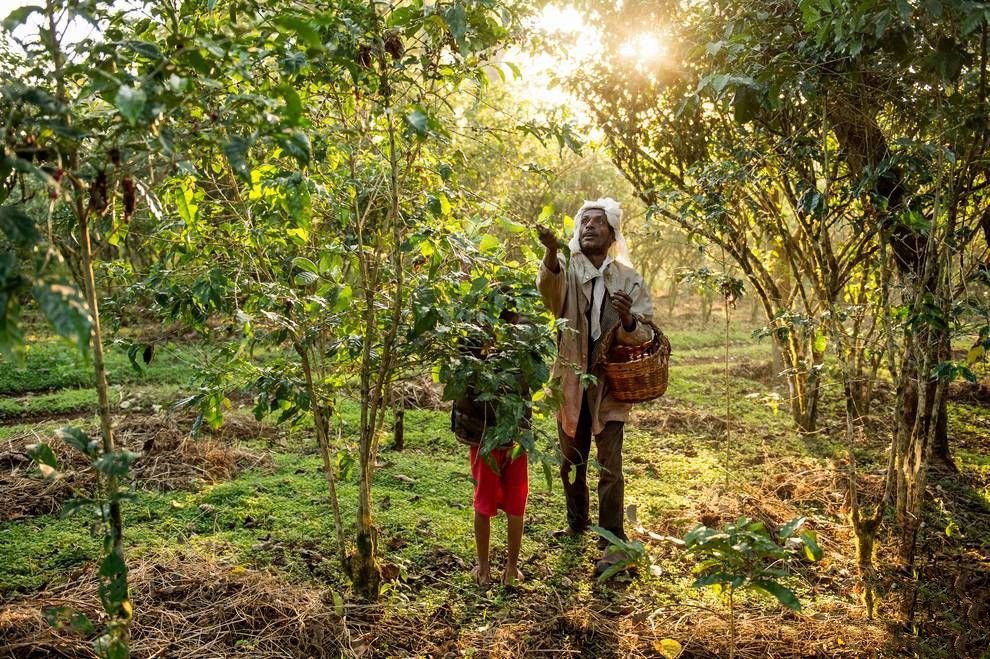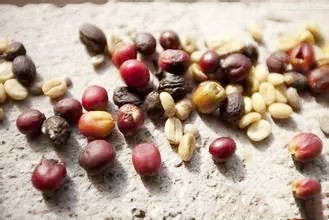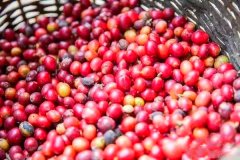Ethiopian pastoral coffee cultivation system coffee bean cultivation system distributed in Ethiopia

(photo from: national Geographic Chinese website Photography: Amivitale,Panos)
According to Qianjie Coffee reference data, nearly 1.2 million of small farmers in Egypt depend on coffee cultivation for a living, each with a planting area of less than 4 hectares, an average planting altitude of 1000-2300 meters, a planting density of 1000-1800 coffee trees per hectare, and a yield of nearly 600kg per hectare.
Coffee cultivation is mainly in the western and southern regions, and small farmers account for 90% of the total planting.
90% of coffee in Ethiopia comes from pastoral, forest and semi-forest, but large-scale entrepreneurial cultivation is rare in Ethiopia.
Coffee cultivation in Ethiopia can be divided into four categories according to scale and pattern:
1, Forest Coffee Forest Coffee
Refers to wild coffee, which accounts for 10% of Ethiopia's national output and is distributed in the wild coffee forest areas of the west and southwest, also known as the Kafa forest. The dense trees here provide the most natural shade for coffee trees and do not require manual care. Mother Earth is in charge of birth, aging, sickness and death, protected by the government, and specially assigned to harvest.
2, half Forest Coffee Semi-Forest Coffee
Refers to semi-wild coffee, accounting for 35% of Ethiopia's coffee production, in the following order: Brazil, Vietnam, Colombia, Indonesia, Ethiopia, India, Peru, Mexico and Guatemala. In the forest of Kafa in the west and southwest. In order to increase the yield, the farmers of the forest coffee system will each choose a small piece of wild woodland and artificially trim the branches and leaves that are too dense to balance shade and sunlight, assist coffee trees in photosynthesis and growth, and weed once a year to increase coffee production. That is, we often talk about increasing light transmittance and fruit yield. This system uses semi-natural and semi-artificial way to cultivate coffee trees.
3, pastoral coffee Garden coffee
Farmers plant coffee trees in their own backyard or farmland and mix them with other crops. the coffee yield of this system reaches 50% in Ethiopia. Although the density of coffee trees is the lowest, there are only 1000-1800 coffee trees per hectare, but it is the most popular. Because the hybrid method is best in line with the livelihood needs of farmers, is currently the main way of cultivation of coffee in Ethiopia. The small-scale farming system of pastoral coffee is mainly distributed in Sidamo and the southeast in the south, and the government is vigorously promoting the cultivation of pastoral coffee.
4, planting farm coffee PIantation Coffee
This system adopts modern agronomic management, and there are regulations on fennel breeding, pruning, fertilization, spraying, planting density and so on. It is the only non-organic cultivation method at present, but it only accounts for 5% of the national annual output. Land opened up by the state or private sector for efficient mass production and planting, accounting for 5% of Egypt's coffee production and 10% of Egypt's coffee production.

From the above four major systems, it can be seen that Ethiopia is different from the efficient cultivation of enterprises and science and technology in Central and South America. Most of the coffee in Ethiopia is mixed with wild and artificial, so it is not easy to increase the yield. But Egyptian agricultural experts are not discouraged and are already cultivating high-yield, high-quality Arabica mixed-race coffee trees, hoping to narrow the yield gap with Central and South America.
These four major planting systems are distributed in the following nine major producing areas of Ethiopia: Jinma, Sidamo, Yegashifi, Hara, Lim, Iruba, Gimbi (Lekanti), Tibby, and Bebeca. On the whole, the flavor of each producing area has its own characteristics, basically, the beans of Tiebi, Bebeca, Irubabo in the west and Tana Lake in the northwest are obviously larger, the game is heavier but the fruit acidity is lower. On the other hand, the Lim in the middle, Yejasuefei and Sidamo in the middle and south, with rich fruit flavor, flower and sour aroma, are relatively stable in quality. Hara in the east has both the game of the west and the fruit of the south-central part, but there is a big difference between the good and the bad.
The above is some information about Ethiopian coffee beans sorted out by Qianjie Coffee.
I hope this article can help you to learn more about Ethiopian coffee.
.
Important Notice :
前街咖啡 FrontStreet Coffee has moved to new addredd:
FrontStreet Coffee Address: 315,Donghua East Road,GuangZhou
Tel:020 38364473
- Prev

Whether the handle of espresso should be buckled back to make the head or the effect of room temperature on the flavor of coffee
Professional coffee knowledge exchange more coffee bean information Please pay attention to the coffee workshop (Wechat official account cafe_style) after the guide to extract espresso, should the handle be fastened to the brewing head to keep warm or should it be placed at room temperature? Baristas have different views on this issue. Some baristas think that the handle buckle on the brewing head can keep the whole handle (including powder bowl) at the same temperature.
- Next

Ethiopia Coffee bulk Commercial Bean producing area: Jinbi / Lekemp 05
Altitude: 1500-2100 m forest / semi-forest coffee system harvest time: February-April around the two cities of Ghimbi and Lekempti producing area names often appear jointly. Coffee roasters can use either or both. Lekempti is the capital of the region, but coffee beans with that name may come from the city of Ghimb, 100km away. Grew up in Siegopi.
Related
- Beginners will see the "Coffee pull flower" guide!
- What is the difference between ice blog purified milk and ordinary milk coffee?
- Why is the Philippines the largest producer of crops in Liberia?
- For coffee extraction, should the fine powder be retained?
- How does extracted espresso fill pressed powder? How much strength does it take to press the powder?
- How to make jasmine cold extract coffee? Is the jasmine + latte good?
- Will this little toy really make the coffee taste better? How does Lily Drip affect coffee extraction?
- Will the action of slapping the filter cup also affect coffee extraction?
- What's the difference between powder-to-water ratio and powder-to-liquid ratio?
- What is the Ethiopian local species? What does it have to do with Heirloom native species?

